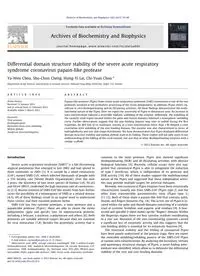
2012 Differential domain structure stability of the severe acute respiratory syndrome coronavirus papain-like protease PDF
Preview 2012 Differential domain structure stability of the severe acute respiratory syndrome coronavirus papain-like protease
Differential domain structure stability of the severe acute respiratory syndrome coronavirus papain-like protease Ya-Wen Chou, Shu-Chun Cheng, Hsing-Yi Lai, Chi-Yuan Chou ⇑ Department of Life Sciences and Institute of Genome Sciences, National Yang-Ming University, Taipei 112, Taiwan a r t i c l e i n f o Article history: Received 12 January 2012 and in revised form 21 February 2012 Available online 3 March 2012 Keywords: Viral protease Deubiquitination Reversible three-state unfolding Molten globule Analytical ultracentrifugation a b s t r a c t Papain-like protease (PLpro) from severe acute respiratory syndrome (SARS) coronavirus is one of the two proteases involved in the proteolytic processing of the virion polyproteins. In addition, PLpro shows sig- nificant in vitro deubiquitinating and de-ISGylating activities. All these findings demonstrated the multi- functional nature of the PLpro. Here we report the sensitivity of PLpro to denaturant urea. An increase in urea concentration induced a reversible biphasic unfolding of the enzyme. Differently, the unfolding of the catalytic triad region located within the palm and thumb domains followed a monophasic unfolding curve. Further observations suggest that the zinc-binding domain may start to unfold during the first transition. An 80% lost of its enzymatic activity at a urea concentration lower than 1 M showed a close correlation with unfolding of the zinc-binding domain. The enzyme was also characterized in terms of hydrophobicity and size-and-shape distribution. We have demonstrated that PLpro displayed differential domain structure stability and molten globule state in its folding. These studies will not only assist in our understanding of the folding of this viral enzyme, but also that of other deubiquitinating enzymes with a similar scaffold. � 2012 Elsevier Inc. All rights reserved. Introduction Severe acute respiratory syndrome (SARS)1 is a life-threatening atypical pneumonia that emerged in late 2002 and had spread to three continents in 2003 [1]. It is caused by a novel coronavirus (CoV), named SARS-CoV, which infected thousands of people with a 15% fatality rate (World Health Organization). Over the next 2 years, the discovery of two more species of human CoV, NL-63 and HCoV-HKU1, confirmed the high mutation rate of coronavirus- es [2,3]. Recent isolation of SARS-CoV like strains from bats further raises the possibility of a reemergence of SARS or a related disease [4,5]. All of these findings result in an urgent need to understand these viruses and their encoded proteins better. SARS-CoV has two cysteine proteases, a main protease and a papain-like protease (PLpro); these are able to cleave the virion polyproteins (ppla and pp1ab) into 16 nonstructural proteins, including a helicase, a nuclease, a polymerase and others [6]. Both proteases are suitable antiviral targets because they are essential for viral maturation [7,8]. Besides the proteolytic activity that is common to the main protease, PLpro also showed significant deubiquitinating (DUB) and de-ISGylating activities with obscure biological functions [9]. Recently, cellular assays have also sug- gested that coronaviral PLpro is able to antagonize the induction of type I interferon, which is independent of its protease and DUB activity [10]. All of these studies support the multifunctional nature of the PLpro and suggested that these independent activi- ties may provide multiple targets for antiviral therapies. Recently, two coronaviral PLpro enzymes have been structurally characterized, namely one from SARS-CoV (PLpro type 2) and the other from transmissible gastroenteritis virus (PLpro type 1) [11,12]. Both of them share a papain-like fold that contains palm, thumb, and fingers domains (Fig. 1A). The active site of PLpro is lo- cated within the palm and thumb domains consisting of a catalytic triad of cysteine, histidine, and aspartic acid residues [9]. A four- strand anti-parallel b-sheet makes up the ‘‘fingers’’ domain. Within the fingertips region there are four cysteine residues coordinating to a zinc ion. Mutation of the zinc-coordinating cysteines caused a significant loss of enzymatic activity and this suggests that the zinc-binding ability is essential for its enzymatic function [9]. The structural stability and the folding of coronaviral PLpro have been poorly understood at the present stage. Here we report the reversible unfolding/refolding process of the SARS-CoV PLpro at various urea concentrations. By analyzing the secondary, tertiary and quaternary structural changes of PLpro, a novel folding inter- mediate was identified, which allow us to delineate the differential stability of the core and zinc-binding domains. 0003-9861/$ - see front matter � 2012 Elsevier Inc. All rights reserved. doi:10.1016/j.abb.2012.02.015 ⇑ Corresponding author. Fax: +886 2 28202449. E-mail address:
